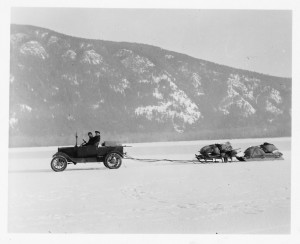February 10, 2012
It was curiosity about the original settler on our property and the person our community, Lee Creek, was named after that sparked my interest in local history. After interviewing most of the remaining sons and daughters of the original pioneers, my research expanded with a visit to the provincial archives in Victoria. One of the best sources of information there are the original pre-emption records for nearly every original settler in the province.
Most of all the settlement in the Shuswap and throughout the province stems from the policy of pre-emption, also known as homesteading, that first began in 1859 as a means for incoming settlers to obtain temporary title. Blocks of vacant, non-reserved, un-surveyed Crown land, ranging in size from 40 to 320 acres were first selected and staked by the pre-emptor, who submitted an application and then received a certificate. After the applicant’s residency was confirmed, the land was surveyed and improvements were made; title could be granted for no charge or the land could be purchased at a discounted rate.
The process in the Shuswap was made more complicated because much of the land here was in the Railway Belt and was thus under control of the federal government. The CPR had been granted a 40-mile wide strip on either side of the track in return for building the railway. This land was traded for land up north to allow for settlement. Consequently, the federal government administered a homesteading process that was nearly identical to the provincial pre-emption process.
During my visit to the archives, I was able to obtain copies of the pre-emption records for many of the North Shuswap settlers. The earliest record for Lee Creek is for Henry Hopwood, a remittance man who first homesteaded above Indigo Bay. He built his first log house, 20 by 24 feet, in 1899 and cleared 3 acres. By 1905 he had cleared 10 acres, constructed a 200-rod long fence and a 60-rod long ditch along with a log stable. And by 1907, he had received the title for the property, where he and his wife Nancy, who was half Blackfoot Indian, eventually raised 8 children.
David Wright first homesteaded our property in 1913; however, he soon abandoned it for lack of funds. It was next taken up by Ray Corning, a civil engineer, who built his house in 1915 and then went off to serve in WW I from 1916 to 1919 and returned suffering from neurasthenia. Although he managed to build a road and burn and seed 8 acres by 1920, he too abandoned the homestead and moved his house to another property closer to the lake.
Corning eventually recovered and went on to become a successful highway engineer in Salmon Arm. Sometime in the 1940s, Lee Creek, which was first named after gold prospector Billy Lee who built a log cabin there in 1886, was renamed after Ray Corning. It is likely one of the only creeks in the province that has a bridge sign with two names, and with the original name in parenthesis!
For many of the original settlers, a further requirement existed that complicated and delayed the pre-emption process. Many properties were also tied up in timber berths. Forest companies had the rights to the timber and this timber had to be removed before the settlers could obtain titles.
In some cases, settlers were considered mere squatters where lumber companies controlled the land base and conflicts sometimes occurred. In 1909, a dominion land inspector made a report that recommended that homesteads be reduced from 160 to 40 acres. As a result, settlers on the North Shuswap became irate and along with the Kamloops Liberal Association sent a strongly worded letter to Prime Minister Laurier threatening him that he would lose all his political support unless the proposed changes were scrapped.
Many meetings were held and in August 1910 Lee Creek pioneer Oliver Freeman and Celista pioneer Will Riley joined with other Liberals to present a petition to Laurier during his train visit to Kamloops. Charlie Riley remembered how, “they came back with smiles on their faces as Wilfred said no 40, we’ll see that you get a 160 acres.” The group then formed a settler’s association to continue to fight for settlement and also served as the ad hoc government for the North Shuswap.
Three years later, the settlers finally received entry on their lands and their association became the Farmer’s Institute that went on to lobby successive governments for improvements, including roads, bridges, wharves and ferry services. For those of you who are also curious about the Shuswap’s first homesteaders, most pre-emption records are now available online and searchable either by legal description or by name and there is an index to these records at the R.J. Haney House archives.
Postscript:
This column neglects the fact that the land allocated for the settlers was basically stolen from the first nation peoples. Adding insult to injury, was the policy that allocated only 20 acres per native family when the reserves were set up. The powers that be in those days somehow saw a need to provide 80 to 320 acres for the white settlers, while the indigenous peoples only received 20 acres. Despite this meagre allotment, many first nation reserves actually became quite successful in the very early days at farming. As a result, policies were developed to thwart this success, as their meat and produce was creating competition for the settler farmers and life then began to go further downhill for many bands, especially when their children were sent to the residential schools.
This old photo shows Captain J.J. Smith driving his Model-T Ford pick-up truck on the frozen lake delivering the mail from Sicamous to Seymour Arm. His son, Frank may be in the passenger seat.







